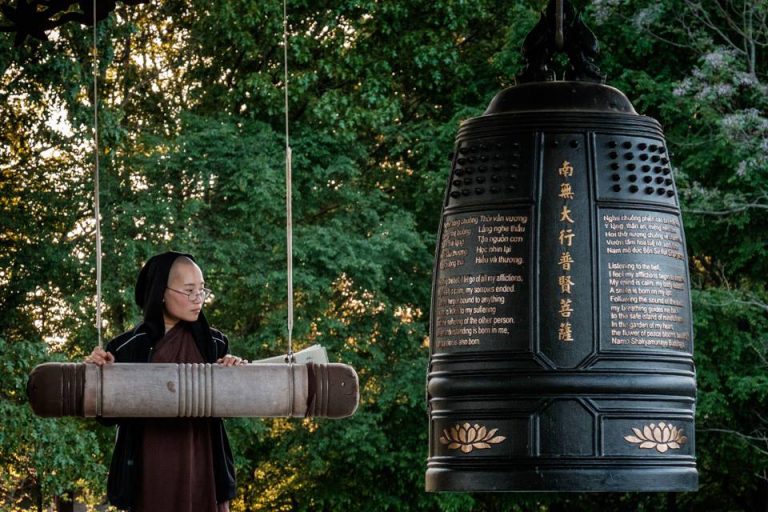Bells break in on our cares in order to remind us that all things pass away and that our preoccupations are not important. They speak to us of our freedom.
—Thomas Merton
If you visit a practice center in the Plum Village tradition of Vietnamese Zen Master Thich Nhat Hanh, you’ll likely notice special signs along the road, in the parking lot, at a trailhead, or around a bend.
A speed bump may be marked with the words “mindful bump” or “stop and breathe.”
A plank on a tree may be engraved with calligraphy that reads, “breathe, you are alive.”
And visitors grow accustomed to the bells that announce the dawn chant, dharma talks, and other events. Bells often find me reviewing the past or rehearsing the future. When we hear a mindfulness bell, we stop and return to our conscious breathing. We consider the sound of a bell the voice of the present moment reminding us to return to our true home in the here and now.
Learning to pause has become a daily habit. When I hear a bell, I stop whatever I’m saying, thinking, or doing. I let my muscles and nerves completely relax, and I bring full attention to my in-breath and out-breath. I smile and simply be. Nothing else. Just three conscious breaths can restore me to a cool and clear state of being. Whatever or whoever is front of me is more real. My work is pleasurable. My relaxation is more fulfilling. My mindfulness blooms.
There are many apps that can play meditation bells for us at designated intervals. But we don’t need a literal meditation bell to remind us to be mindful. Our prompt could be the sound of a bird, a truck, or the wind through the trees. A mindfulness bell doesn’t even need to be acoustic—it could be the sight of a cloud drifting or a baby smiling, the fragrance of flowers or the feeling of warm sunlight on our bare skin.
When you hear the call, whatever it may be: stop, breathe, and smile.
Mindfulness-bell practice can hold delicious surprises. Once, I was teaching qi gong on the beach at Aquatic Park in San Francisco and—Ding! I heard a bicycle bell. Well, I couldn’t stop. I was responsible to a class closely following my moves. But I stopped whatever concepts I had about teaching, or qi gong, and fully melted into the moment with my movement. I recall how fresh the ocean breeze felt in that instant.
One time, when I was halfway through a five-day retreat, I entered the big hall, found my cushion among my friends and, at the sound of the bell, bowed and waited for the inevitable announcement of that day’s events. I was flexible for a possible change of plans. Maybe our speaker was late, that sometimes happens. A few moments went by and still nobody said a thing. I looked across the aisle and saw my friend Chinh, looking at nothing in particular, with a gaze that said to me, “Ho hum, what’s next, let’s see.” So I figured I was joining everyone waiting and continued to sit, enjoying my breathing.
It wasn’t until 10 or 20 breaths later that I realized there is no next. This is it. We’re all just sitting here. And here I am, not “practicing” anything at all, just sitting and continuing to do so for 30 or 40 minutes with nothing to gain and nothing to attain. No Zen to find in the Zen center except what I brought there. Just letting be. I felt calm, alert, and grateful just being still, and very happy to be so.
When I’m sitting in meditation at home, I might hear the bell of a nearby church. I’m already doing nothing, so what do I stop? I might let go of any concept of meditating and what I’m experiencing, becoming aware of awareness itself and more fully inhabiting the present moment.
And when I’m arriving at my front porch—Ding ding!—I might hear a passing cable car bell. Then I might find myself coming home to coming home. As the Jamaican poet Derek Walcott said, “greet yourself arriving at your own door.”
When I first began mindfulness-bell practice, I remember falling in love with the sound. I wanted to embrace the ringing and hug it to my heart. Later, I came to appreciate it as mirroring my own human condition. Now, sometimes I smile when I realize how neatly the sound of a bowl bell can last for a full three breaths and is an efficient way of emptying out and beginning anew.
Over the years, I’ve come to enjoy mindfulness bells as both training my discipline and as a release. As such, it epitomizes how the practice is for me both commitment and surrender. Or, in a word—Ding!
♦
This article was originally published on July 5, 2016
Thank you for subscribing to Tricycle! As a nonprofit, we depend on readers like you to keep Buddhist teachings and practices widely available.
